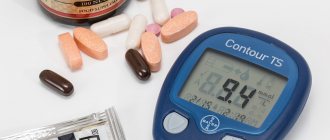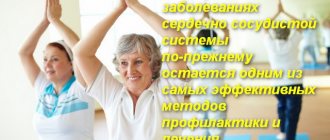Therapeutic physical education (PT) is used as an effective method in the treatment of many diseases. Specially developed sets of sports exercises help normalize the patient’s condition in the postoperative period, maintain health stability in chronic pathologies, and prevent complications and exacerbations of the disease. Exercise therapy for diabetics is primarily focused on normalizing glycemia. In addition, gymnastics for type 2 diabetes helps to cope with obesity, which is typical for non-insulin-dependent patients. Physical activity for diabetes mellitus should correspond to the severity of the disease and the individual characteristics of the patient’s body.
What are the benefits of exercise therapy for diabetics?
The main problem with diabetes mellitus (DM) is a violation of the absorption of glucose by tissues and its accumulation in the vascular bed. Excess sugar has a negative effect on the vascular wall and nerve fiber, causing a variety of life-threatening conditions. Physical activity for type 2 diabetes is necessary to solve the following problems:
- Increased glucose consumption by working muscles;
- Stabilization of blood sugar levels;
- Stimulation of immunity;
- General increase in body tone;
- Regulating the tone of the vascular wall and improving blood supply to tissues;
- Stimulating effect on peripheral nerves;
- Weight loss.
Features of exercise therapy
Physical therapy for type 1 and type 2 diabetes is extremely important. Thanks to it, there is a tangible increase in the patient’s quality of life:
- the body's sensitivity to insulin increases;
- glucose levels decrease, blood composition improves;
- development of muscle mass;
- weight is normalized;
- Nervous tension and stress are reduced;
- the cardiovascular system is strengthened.
Exercise therapy can reduce sugar concentrations to normal levels and reduce the dose of insulin required. The general impact of physical activity strengthens the immune system, eliminates the manifestations and consequences of adynamia.
Insulin and exercise
In the insulin-dependent form of diabetes, the likelihood of developing hypoglycemia increases, since active muscle work has the ability to reduce the concentration of sugars in the blood serum. Therefore, you should start training no earlier than 50-60 minutes after eating and injecting insulin. We also do not recommend putting insulin in those muscle groups where the main load is planned.
If during exercise you notice episodes of decreased glucose, then you can first eat a sandwich or other carbohydrate food. If your blood sugar still drops significantly, you should consult your doctor: it may be advisable to reduce the single dosage of insulin before training.
Attention!
If during the exercise you feel general weakness, dizziness, trembling in the limbs, or an acute feeling of hunger, then you need to immediately stop the workout and chew something sweet, for example, candy, a piece of sugar, a glucose tablet.
Indications and contraindications
Physical therapy is indicated for mild to moderate diabetes mellitus. In case of severe disorders, the question of the admissibility of therapeutic exercises is decided by the doctor individually; this is necessary to avoid possible complications of diabetes due to muscle strain.
There are a number of conditions in which exercise therapy is contraindicated for diabetics:
- Exacerbation of the disease, high blood glucose levels (more than 13-16 mmol/l);
- Development of hypoglycemia during training (sugar below 4.5 mmol/l);
- Severe concomitant pathologies of blood vessels and heart (rhythm disturbances, heart failure, aneurysms of large vessels);
- Severe retinal pathology;
- High levels of acetone in urine;
- Constant intense pain in the calf muscles;
- Infectious diabetic complications.
Severe diabetes
As a rule, severe diabetes is accompanied by diseases of the cardiovascular system. This should be taken into account when choosing a load on the body: the intensity should be low or moderate.
Therapeutic exercise is aimed at developing small and medium muscles. As adaptation progresses, large muscles can also be involved.
Exercises should be performed at a slow pace, but for a long duration. With this approach, not only the glycogen stored in the muscles is used up, but also glucose.
Classes should be correlated in time with insulin injections and meals. Otherwise, training may lead to hypoglycemia, followed by hypoglycemic coma.
You can also do exercises while on bed rest. They should include elements of breathing exercises. The main rule is to avoid overwork.
Loads at different degrees of disease severity
Depending on the value of laboratory indicators of glycemia during the disease, on the presence of diabetic neuropathy, angiopathy, damage to the retina, type 2 diabetes is divided into mild, moderate and severe. For each form, a set of exercise therapy exercises has its own characteristics.
Mild severity
The workout lasts about 35 minutes and includes gymnastic elements that affect different muscle groups. Exercises are performed at an average pace for large muscle groups or at a fast pace for small ones. High-amplitude exercises, weights, and the use of special equipment are allowed: dumbbells, gymnastic sticks, wall bars, benches.
In addition to training, time should also be allocated for walking. You should walk at an average pace, gradually increasing the distance. If in the first days the distance is 5 km, then gradually it will need to be increased to 15 km.
Other permitted physical activity for mild diabetes includes:
- Swimming;
- Water aerobics;
- Race walking and jogging;
- Skiing (Nordic walking) and skating;
- Rowing;
- Some dynamic games (tennis, badminton).
Moderate severity
A complex of physical therapy for moderate diabetes mellitus also includes training of all muscle groups and is aimed at stabilizing the condition and selecting adequate dosages of medications.
Charging time averages 25 minutes. Walking is allowed for a distance of 7 km at an intensity of 115 steps per minute.
It is possible to combine exercise therapy with massage and hardening procedures.
Severe pathology
In case of serious complications of diabetes, excessive movements and heavy loads are prohibited. The duration of the workout should not exceed a quarter of an hour. All tasks are performed at a slow, measured pace, but for a long time, so that both glycogen from the muscle fiber and glucose itself are broken down and absorbed.
Note!
It is important to pay attention to the patient's condition. If there is a feeling of shortness of breath, palpitations or weakness, then the training should be stopped.
If you follow bed rest, dosed physical exercise in a supine position and breathing exercises are possible.
Mild diabetes
With a mild form of diabetes, you can practice gymnastics for all muscle groups. You need to work with high amplitude at a medium to slow pace. First, small muscles are worked, then exercises that require increased coordination are introduced. At this stage of the disease, it is permissible to use weights and special equipment. The workout usually lasts 30–40 minutes with a fairly intense load.
For mild diabetes mellitus, exercise therapy can include brisk walking (from 5 to 12 km), skiing, swimming in the pool, skating, jogging, rowing, sports games and other various exercises. All classes must be carried out under the supervision of the attending physician, and the trainer must be warned about your condition.
A set of exercise therapy exercises for diabetes mellitus
Before physical activity, for diabetics with type 2 disease, it is recommended to perform breathing exercises; the second stage is to begin physical education:
- Inhaling, take a step back with one foot, stretching your arms towards the ceiling. As you exhale, return to the original position.
- Straightened arms are extended to the sides and circular movements are made in the elbow joints, alternately inward and outward.
- They perform a task similar to the second one, but rotation is carried out in the shoulder joints.
- The legs are spread wider, the palms are placed on the waist. Turn the body to the right and left, spreading the arms wide.
- In a horizontal position, the legs are extended towards the ceiling. Inhaling, they are pulled apart in different directions, exhaling, they are connected.
- They do the traditional “bicycle” exercise, simulating pressing the pedals.
- Sitting on the floor, spread your legs wide. Bend over the whole body with arms extended upward, sequentially towards the right leg, towards the left and between them.
- Bring your legs together and reach for your feet with your fingertips.
- They walk in place for several minutes, throwing their knees high.
- Then they alternate walking on tiptoes and on their heels.
Each exercise must be performed at least 10 times.
Exercises while standing
In the initial standing position (your legs should be at shoulder level), you can perform the following simple exercises:
- swinging your legs (you need to place your hands straight in front of you and alternately swing each leg, trying to reach your palms);
- squats (they need to be done 6-8 times in 1 approach, it is better to perform the exercises slowly, trying not to lift your heels off the floor);
- steps back and forth (when taking a step, you need to take a deep breath and raise your arms above your head, closing them, and as you exhale, lower your arms to your body and the leg returns to its original position).
When swinging and stepping to the sides, the blood flow of the large vessels of the legs improves, and the muscles of the lower leg and thigh actively work. Squats are beneficial for diabetes as they develop stability in the feet, activate all muscle groups in the legs and in addition help relieve the problem of constipation. The duration of such gymnastics should be 10-15 minutes. This, like any other, set of exercises is not advisable to perform immediately after eating.
Combining leg exercises with other forms of light physical activity can help maintain normal blood sugar levels and overall well-being.
Exercise therapy for diabetic feet
Malnutrition of the lower extremities is a very common phenomenon in diabetes. This is associated with polyneuropathy and angiopathy (disruption of blood vessels and nerves), which cause pain in the limbs and changes in the skin, including the formation of trophic ulcers. That is why a special 10-minute exercise therapy complex for legs with diabetes was developed:
- While sitting, we bend and straighten our toes.
- In the previous position, we place our feet on the heels, the front of the foot is raised up. Bring your toes together and spread them apart.
- We stretch our legs in front of us and, holding them suspended, draw circles and numbers with our thumbs.
- We put the newspaper on the floor. We roll it into a ball with our feet, then smooth it out without using our hands and tear it into pieces, holding it between our toes.
- We get to our feet. We rise on tiptoes, spread our heels to the sides, then lower ourselves to the floor with our full feet.
- We imitate walking in place, lifting only the heels from the support.
- We sit on the floor and stretch our legs. We alternately bend our feet towards and away from ourselves.
- Pull up your toes. We alternately pull our right and left legs towards us.
- We slightly raise our leg on the floor, pulling the foot towards us, then lower it and pull it towards us. Repeat on the other leg, and then with both legs together.
All elements must be done 10 times.
Therapeutic walking techniques
For maximum therapeutic effect, it is recommended to engage in walking on rough terrain in a park or forest, as fresh air has a beneficial effect on the entire body. But in most cases this is not possible, so patients perform it at home.
For untrained people, walking in place is an excellent alternative to cardio training.
The best option is to walk in place, during which you must always monitor your posture and completely lift your feet off the floor. It is important to always maintain rhythmic breathing, inhaling and exhaling air as much as possible. To prevent physical activity from harming the health of a diabetic, the exercise time should not exceed 3–4 minutes.
Gymnastics for the eyes for diabetes
The vessels of the eyeball are the smallest and narrowest, therefore, when the level of glucose in the blood is elevated, the blood flow in them is disrupted first. If measures are not taken in time, you can lose your vision irrevocably. This is why eye exercises for patients with diabetes are so important. It helps slow down pathological processes in the retinal arteries. After each exercise, you need to close your eyes for 30 seconds to give them time to adapt.
- First you need to close your eyes and make 6 short light pressures on the eyeballs, then open them for 6 seconds. Repeat the exercise 3 times.
- Close your eyes tightly, then open them for 6 seconds. Repeat six times.
- Blink for 2 minutes in a row without straining.
- Fix your index fingers in front of your eyes at a distance of 40 cm. Spread them to the sides as far as possible, keeping them in sight.
- Alternately fix your gaze on your fingers, then on objects located behind them.
- Looking down, rotate your eyeballs clockwise. Then look up and continue rotating in the opposite direction.
- Gently stroke the upper eyelids from the outer corner of the eye to the inner corner 9 times, and vice versa for the lower eyelids.
- Close your eyes for a few minutes.
Qigong for diabetics
The Chinese health practice of qigong (translated as “energy work”) is already 2 thousand years old. Gymnastics is suitable for the prevention of disease in prediabetes and for diabetics. By controlling movements and breathing rhythm, yoga helps to release trapped energy, which makes it possible to experience mental and physical harmony.
- Place your feet shoulder-width apart, knees straight, but without tension. Check muscle relaxation and remove excess stress from the lower back. Arch your back like a cat, straighten up again and retract your tailbone as much as possible. Return to IP.
- Lean forward, arms dangling relaxed below, legs straight. If this position provokes a lack of coordination, you can lean against the table. When your hands are on the tabletop, your torso should be pushed back as far as possible and be in the same plane with them. As you inhale, you need to straighten up and raise your arms in front of you. Move until your torso begins to bend back.
- In order not to put pressure on the lumbar vertebrae, the load on this area should be minimal. The arms are bent at the elbow joints, the thumb and index fingers are connected above the head. Inhale and exhale several times, straighten up, keeping your arms in the same position. Exhaling, lower to the chest. Pause, check that your back is straight and your shoulders are relaxed. Give up.
Before starting gymnastics, you need to get ready - close your eyes, inhale and exhale 5 times and maintain the same free breathing during practice. When practicing, it is important to turn to your faith or simply to the cosmos - this will enhance the effect of the lessons.
After completing any complex, the diabetic’s well-being should improve. If fatigue or weakness appears, this is a signal to change the level of stress or temporarily cancel training.
The ancient Greeks said: “If you want to be beautiful, run, if you want to be smart, run, if you want to be healthy, run!” Marathon running is not the most suitable sport for a diabetic, but it definitely cannot do without physical exercise. Do you want to restore your carbohydrate metabolism? Do physical therapy!
Massage for diabetes
Massage in combination with exercise therapy helps with many complications of type 2 diabetes: damage to peripheral arteries and nerve trunks, weight gain, pathology of the joints and spine. Depending on the prevailing symptoms, massage the back, upper or lower extremities. The procedure allows you to improve blood supply to tissues, speed up metabolic processes, stimulate the work of peripheral nerves, and increase the overall tone of the body.
General massage, covering one or several departments, is performed twice a week for half an hour. Diabetics are allowed to do segmental, local massage daily, but not more than 10 minutes.
They use different techniques: kneading, vibration, stroking, rubbing, acupressure.
If diabetes has developed against the background of pancreatic pathology, then it can be influenced by acupressure of the thoracic spine and suprascapular region.
Important!
The procedure is contraindicated in the presence of trophic ulcers, exacerbation of arthropathy, decompensation of diabetes or hypoglycemia.
What diabetics should not do during physical activity
Not all types of physical activity are suitable for diabetics. In particular, it is not recommended to engage in professional sports that require intense training. Contraindicated:
- Weightlifting;
- All types of struggle;
- Fast long distance running;
- Too dynamic team games (football, basketball);
- Traumatic sports.
In combination with drug treatment and diet, therapeutic exercises for diabetes mellitus give excellent results. It is only important to strictly follow the recommendations of doctors. Failure to follow training rules can cause hypoglycemia and other complications.











